by Ioana Maria Cortea — Last updated on September 2, 2025 — Reading time: 20 min
Article sections
» Earth pigments: key technical characteristics » Overview of major earth pigment types » Nomenclature and terminology » Earth pigments in art: history of use » Earth pigments in the INFRA-ART Database » Further reading and resources
The INFRA-ART Spectral Data Collections is a blog article series that highlights key groups of art-related materials represented in the INFRA-ART Spectral Library. Each article focuses on a specific material category—examining its composition, technical details, and history of use—while also showcasing the spectral data collections available within the INFRA-ART database. By connecting material knowledge with accessible spectral reference data, the series aims to support research, education, and interdisciplinary engagement across the cultural heritage field.
Earth pigments are among the oldest materials used in human artistic expression. These naturally occurring pigments, derived from iron oxides, manganese compounds, clays, and other minerals, have been used since the earliest symbolic expressions of humanity and remain vital in both artistic and conservation practices today. Valued for their sustainability and safety, earth pigments are widely used in natural paints and are regaining popularity in contemporary eco-conscious art practices. More importantly, they are archaeological markers — remnants of color choices made by ancient societies that can tell us about trade routes, resource availability, and artistic conventions. The mineralogical and geochemical fingerprints of earth pigments, often highly complex, can be matched to known geological sources, providing valuable evidence for provenance studies.
In this post, we examine the mineralogy, classification, and nomenclature of earth pigments, explore their historical applications across cultures, and introduce the collections of earth pigments currently represented in the INFRA-ART spectral database.
Earth pigments: key technical Characteristics
Composition and classification of earth pigments: Earth pigments encompass a broad range of naturally occurring mineral mixtures, typically categorized into groups such as iron-rich ochres, manganese-rich wads, umbers, green earths, white earths (including chalk, kaolinite, and diatomite), organic-rich materials like coal and other solid hydrocarbons, and vivianite-bearing blue earths.
The chemistry of earth pigments is inherently complex, shaped by the environmental conditions under which they formed. They typically consist of several chromophore minerals—primarily iron and manganese oxides or hydroxides—alongside a variety of accessory minerals. These accessory phases may include clays, quartz, carbonates (such as calcite or dolomite), and other minor and trace mineral components. The genetic environment also influences key properties of iron oxide minerals, including their hydration state, structural order, and crystal size. Together, these factors determine a pigment’s color, texture, opacity, and binding behavior.
Main groups of earth pigments and their principal characteristics. Source: MDPI
| Group | Alternative names | Color | Main coloring components |
| Ochres | ochre, flesh ochres, variations given by the geographical location of the source (e.g., Bristol ochre) | varying from browns and reds through yellows | iron oxide- and hydroxide-rich earths |
| Siennas | terre de Sienne, terra di Siena, Siena-erde | yellow-brown | iron hydroxide-rich earths + minor amounts of manganese oxides (<5%) |
| Umbers | ombra, terre d’ombre, terra d’ombra, tierra de sombra | warm brown to greenish brown | iron oxides + manganese oxides (between 5 and 20%) |
| Wads | bog manganese, black wad, black earth, manganese ochres | dark brown to black | iron oxides + manganese oxides (c. 50%) |
| Green earths | terra verde, terre vert, green stone | green to bluish green | clay minerals, celadonite or glauconite |
| Humic earths | Cassel earth, Cologne earth, Vandyke brown | rich brown | low-grade coal deposits or lignites |
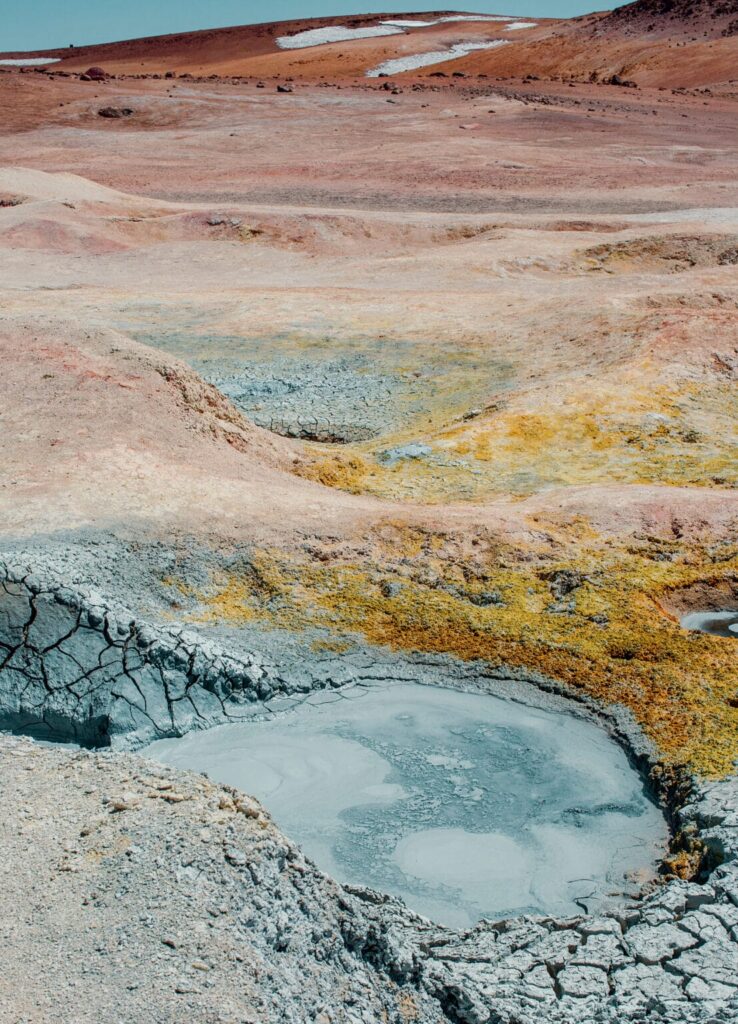
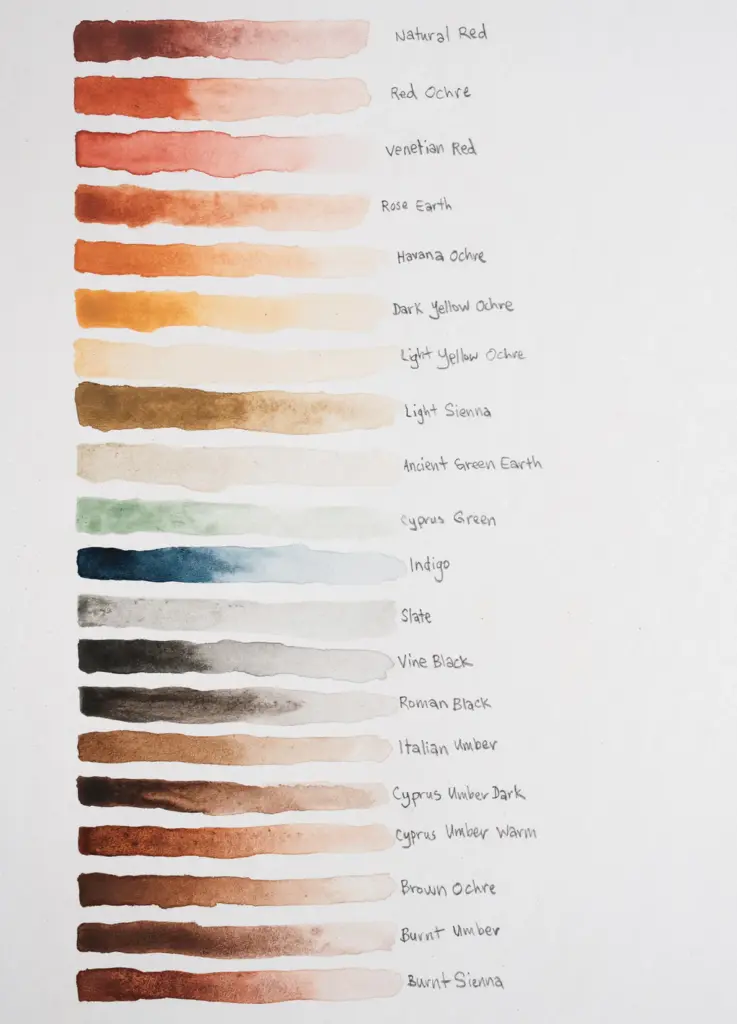
Effect of processing and human intervention: The appearance and behavior of earth pigments can be further altered (to adjust hue, brightness, and working properties) through post-extraction processes such as:
- Drying and grinding – to increase fineness and improve uniformity;
- Washing – to remove unwanted impurities;
- Calcination (heating) – which alters the chemical structure and color, most notably transforming yellow ochres (goethite) into red ochres (hematite);
- Addition of fillers – used to modify hue, texture, or extend pigment volume;
Some of these processing practices were already in use during prehistoric times and reflect an early understanding of how to transform raw geological materials into consistent, workable materials—demonstrating the human capacity to adapt natural resources for artistic and symbolic expression. Found in surface-level deposits, earth pigments were both visible and readily accessible, making them especially appealing to early humans. Archaeological evidence confirms that iron-rich earths have been used for tens of thousands of years to create color.
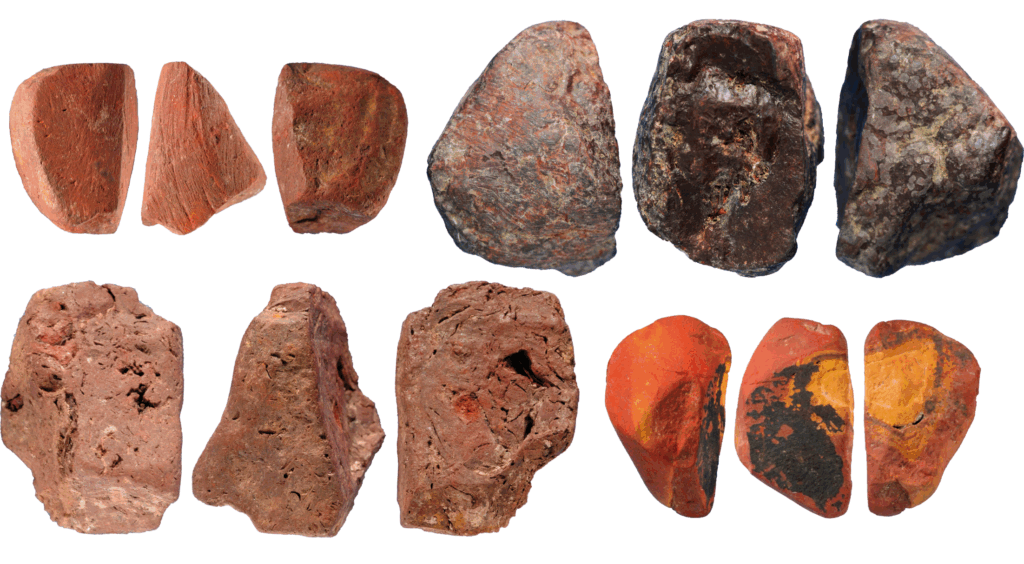
Application properties: Earth pigments are valued not only for their color and stability but also for how they behave in practical use. Their key application properties include:
- High opacity – resulting from their fine particle size and mineral composition, allowing good coverage even in thin layers.
- Matte surface finish – these pigments tend to produce soft, non-glossy coatings, especially in tempera and fresco.
- Low tinting strength – generally weaker than synthetic pigments, which can be advantageous for nuanced blending, glazing, or underpainting.
- Excellent lightfastness – earth pigments are highly resistant to fading, making them well-suited for a wide range of uses.
- Compatibility with various binders – they work well in aqueous (e.g. tempera, watercolor) and oil-based media.
- Non-toxicity – most are considered safe to handle, unlike many historical synthetic pigments.
- Ease of dispersion – their natural particle morphology allows for good mixing and even distribution in paint formulations.
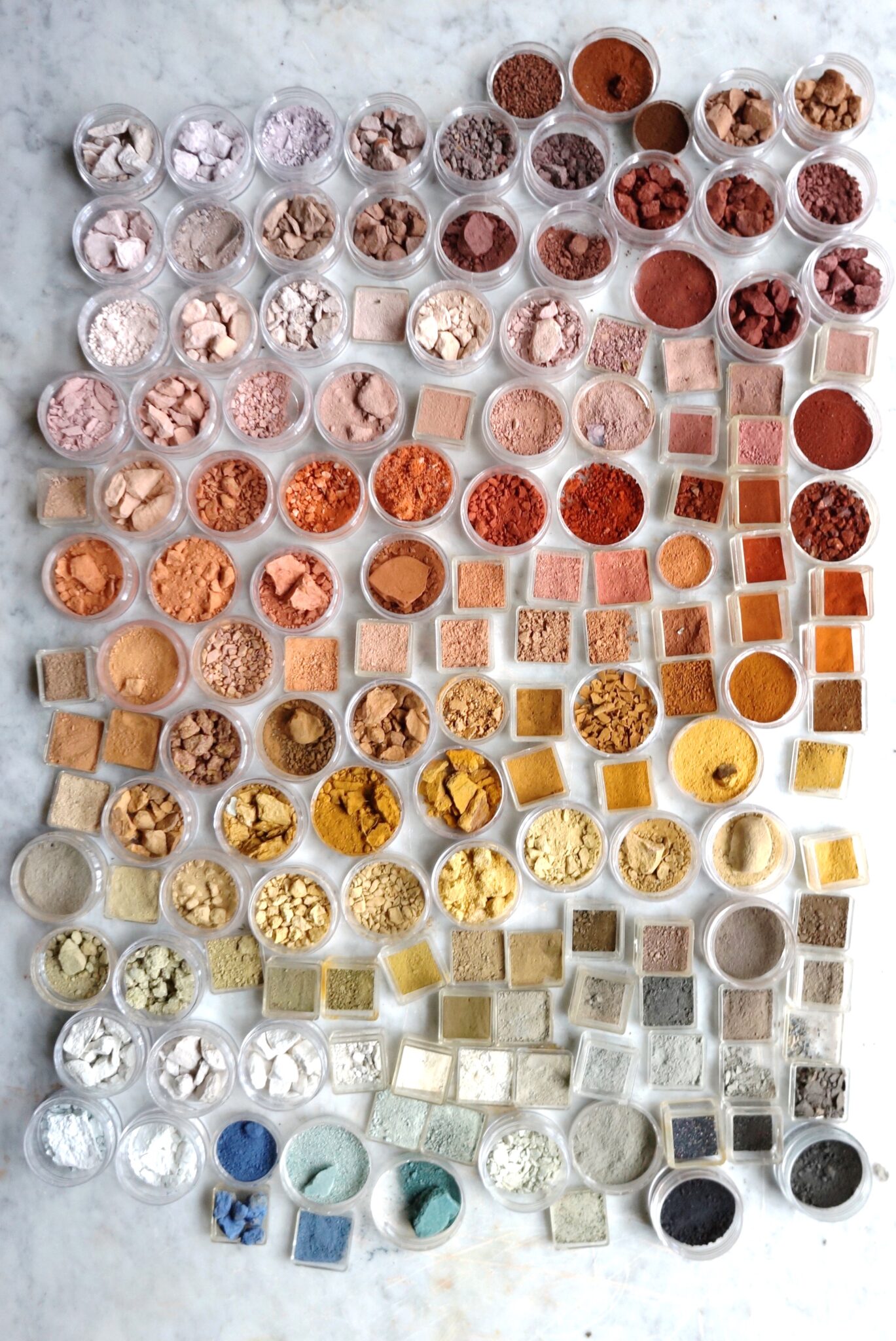
Overview of Major Earth Pigment Types
Earth pigments are commonly classified by their color and mineral composition, yet these categories often overlap due to variations in geological formation, and regional naming traditions. Despite these complexities, a number of broad groupings—such as ochres, umbers, siennas, and green earths—offer a useful framework for understanding their characteristics.
Red Ochres
- Main chromophore: Hematite (Fe₂O₃), an anhydrous iron oxide.
- Color: Deep reds, oranges, and rust hues; can range from dull brick to vivid vermilion-like tones.
- Accessory minerals: Often includes quartz, clays (kaolinite, illite), calcite.
- Formation: Can be natural (precipitation or weathering), or through the calcination of goethite.
- Variations: Color variation depends heavily on particle size and hematite morphology — platy or fine particles produce deeper reds, while coarser ones appear more orange.
- Notable historical sources: Italy (Pozzuoli), Spain, Morocco (Midelt region).
- Nomenclature: Includes terms like Italian red ochre, Venetian red, Pozzuoli red, often with overlapping or regional meanings.
Yellow Ochres
- Main chromophore: Goethite (FeO(OH)), a hydrated iron oxide.
- Color: Ranges from pale yellow and golden hues to warm ochres and deep tans.
- Accessory minerals: Clays (e.g. kaolinite), quartz, gypsum, calcite.
- Formation: Typically formed by weathering of iron-rich rocks in oxidizing environments.
- Processing: Often used raw, but can be heat-treated to convert to red ochre (hematite).
- Variations: Regional variations in yellow ochre typically reflect differences in accessory minerals—e.g. kaolinite-rich ochres are typically linked to French sources, while gypsum- or sulfate-based ochres are more common in Spanish deposits.
- Notable historical sources: France (Roussillon), Spain (Andalusia), Germany (Amberg).
- Nomenclature: Includes terms like French ochre, Amberg yellow, often with overlapping or regional meanings.
Brown Ochres and Umbers
- Main chromophores: Goethite combined with manganese oxides (e.g. pyrolusite, romanechite).
- Color: Warm browns, olive tones, or dark earth colors.
- Composition: Umbers typically contain 5–20% manganese oxides. Below 5%, the pigment may be classed as sienna. Accessory minerals: clays, quartz, calcite.
- Formation: Weathering of iron- and manganese-rich rocks in oxidizing environments.
- Processing:
- Raw umber: Cooler and greenish-brown.
- Burnt umber: Richer, redder brown due to thermal treatment.
- Notable historical sources: Cyprus, Italy (Monte Amiata), Germany, France.
- Nomenclature: Includes raw and burnt umber; sometimes regionally labeled (e.g., Cyprus umber).
Siennas
- Main chromophore: Goethite, with small amounts (<5%) of manganese oxides.
- Color:
- Raw sienna: Transparent yellow-brown.
- Burnt sienna: Deep reddish-brown.
- Formation: Weathering of iron-rich sediments, with low manganese content.
- Composition: Higher iron content than umber, lower manganese; often associated with clay-rich matrices.
- Processing: Heating enhances the red tones by converting goethite to hematite.
- Notable historical sources: Siena, Italy.
- Nomenclature: Now refers more to pigment type than provenance; includes raw and burnt variants.
Green Earths
- Main chromophores:
- Celadonite: Derived from altered volcanic rocks (e.g. Italy, Cyprus).
- Glauconite: Derived from marine sedimentary rocks (e.g. Russia, Germany).
- Color: Soft greens to greyish-blue greens.
- Accessory minerals: Quartz, feldspars, clays.
- Formation: Naturally occurring in iron–magnesium-rich environments; celadonite often in basaltic contexts, glauconite in marine sediments.
- Notable historical sources: Italy, Cyprus, Germany, Russia.
- Nomenclature: Includes terms like terre verte, Verona green, and Bohemian green.
Black Earths and Wads
- Main chromophores: Manganese oxides (pyrolusite, romanechite, todorokite).
- Color: Deep brown to black.
- Composition: Often 30–50% MnO₂; may include hydrated iron oxides and clays or humic substances.
- Formation: Weathering of manganese-rich rocks.
- Notable historical sources: Morocco (Midelt region), Cyprus, Germany.
- Nomenclature: “Wad” is a historical miner’s term for black manganese-rich earths.
Humic Earths
- Composition: Organic compounds—mainly humic and fulvic acids, alongside clay minerals and iron oxides.
- Color: Rich dark brown to nearly black.
- Formation: Derived from lignite, peat, or low-grade coal deposits.
- Variations: Color intensity may vary with humic content and source.
- Notable historical sources: Kassel (Germany), Cologne, and other European lignite deposits.
- Nomenclature: Includes names like Vandyke brown, Cassel earth, Cologne earth.
Nomenclature and Terminology
The nomenclature of earth pigments is a complex intersection of geology, commerce, history, and artistic tradition. While modern scientific methods aim for clarity and reproducibility, the nomenclature of pigments, and earth pigments in particular, has long been shaped by inconsistent conventions, overlapping terms, and regionally-specific language.
Historically, earth pigments have been labeled based on several (overlapping) criteria:
- Geographical origin
Examples: Verona Green, Cyprus Umber, French Ochre, Pozzuoli Red.
These names often reflect the source of extraction — though not always reliably — and have carried associations of quality or prestige (e.g., terra di Siena as a mark of authenticity). - Color and tone
Examples: Light Red Ochre, Deep Yellow Ochre, Raw Umber, Burnt Sienna.
These names are often descriptive but subjective, influenced by visual perception, particle size, or even preparation method. - Processing method
Most notably, the terms raw and burnt indicate whether the pigment has been thermally altered:- Raw sienna (goethite-rich) becomes burnt sienna (hematite-rich).
- Raw umber turns into burnt umber with a redder tone due to dehydration of iron and manganese oxides.
Most of these labels, while useful in artistic practice, lack mineralogical precision. The nomenclature of earth pigments is complicated by longstanding inconsistencies and overlapping terminology. A single material may be known by multiple names, as seen in the Colour Index, which lists dozens of synonyms for ochres, siennas, and umbers. For example, several pigments may share the same Colour Index designation—such as PR 102 (C.I. Pigment Red 102) for red ochre—yet differ significantly in composition and origin. One sample might be a fine-grained hematite with high kaolinite content, while another may have a completely different mineralogical profile. Similarly, names like red ochre, Indian red, Venetian red, and Pozzuoli red are often used interchangeably for iron-rich red earth pigment, despite variations in hue, texture, and regional source. Additionally, branding practices by pigment manufacturers introduce ambiguous trade names like Antique Ochre, or Green Earth Light, which offer no reliable indication of mineralogical composition or geographic origin.
Earth pigments in art: history of use
Earth pigments are among the earliest, most enduring materials used in human artistic expression. Their natural beauty, stability, and widespread availability have made them indispensable across cultures and millennia — from Paleolithic burials to contemporary conservation practice.
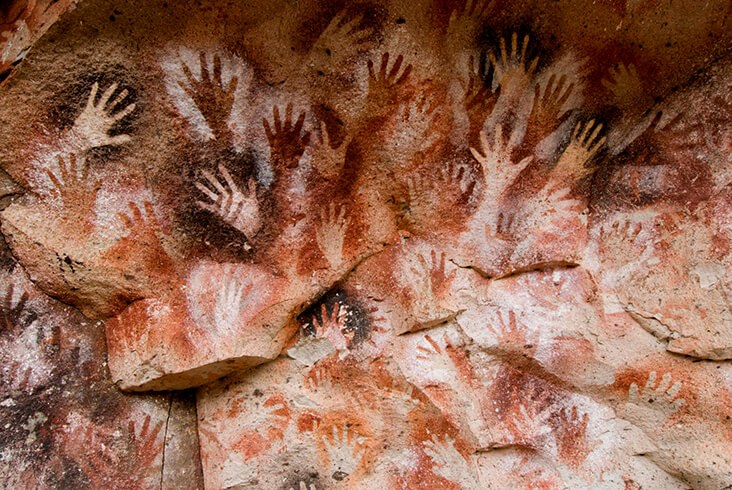
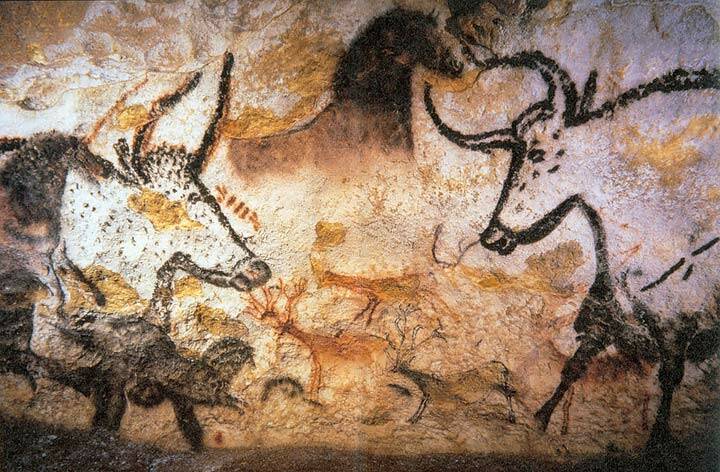
The earliest possible use of ochre identified to date comes from a Homo erectus site found in Kenya estimated to be around 285,000 years old. While this suggests very early engagement with iron-rich pigments, clearer evidence of deliberate ochre processing—such as the presence of raw materials, processing tools and/or storage container—emerges around 100,000 years ago, as evidenced by archaeological discoveries from both Africa and Europe. Red and yellow ochres were used by early Homo sapiens and Neanderthals alike for a range of symbolic and practical purposes. These included body decoration, ritual activities, or burial practices—such as the ochre-covered burial known as the ‘Red Lady’ of Paviland. Ochre was also used extensively in the creation of cave paintings, most famously at sites like Lascaux, Chauvet, and Altamira. In such prehistoric contexts, pigment selection was not purely aesthetic but deeply symbolic. Red ochre, in particular, has long been associated with blood, fertility, life, and transformation, underscoring its powerful cultural significance.
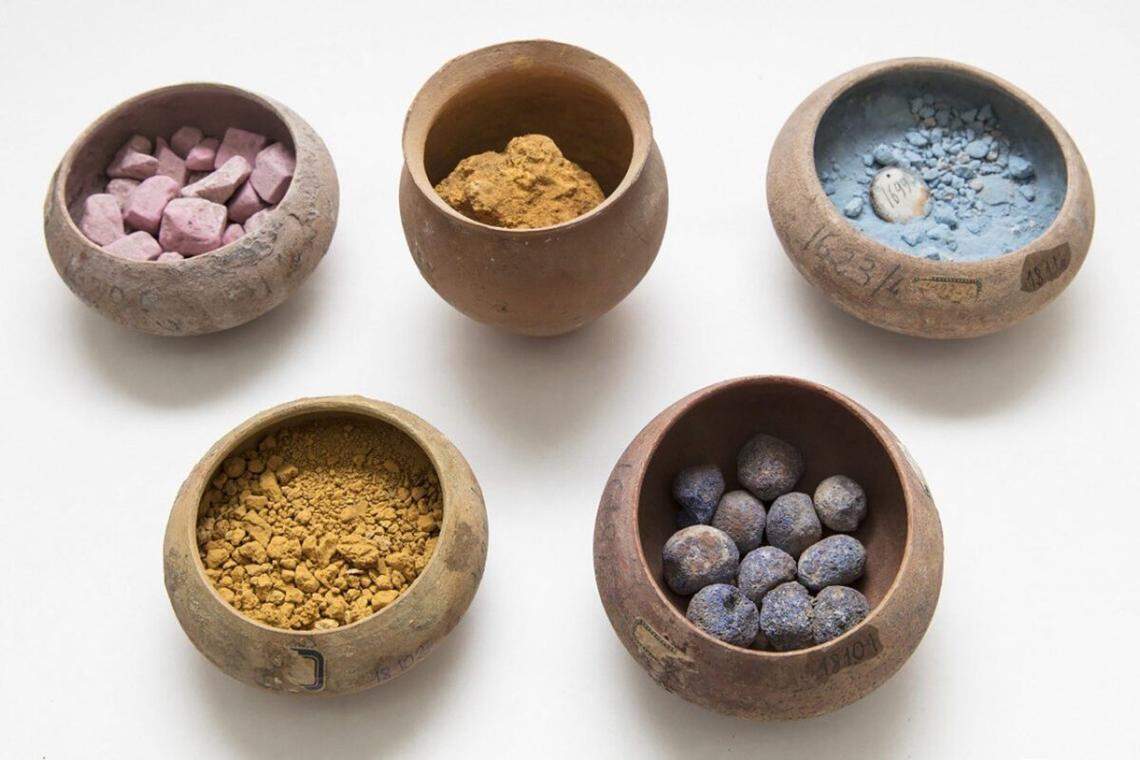
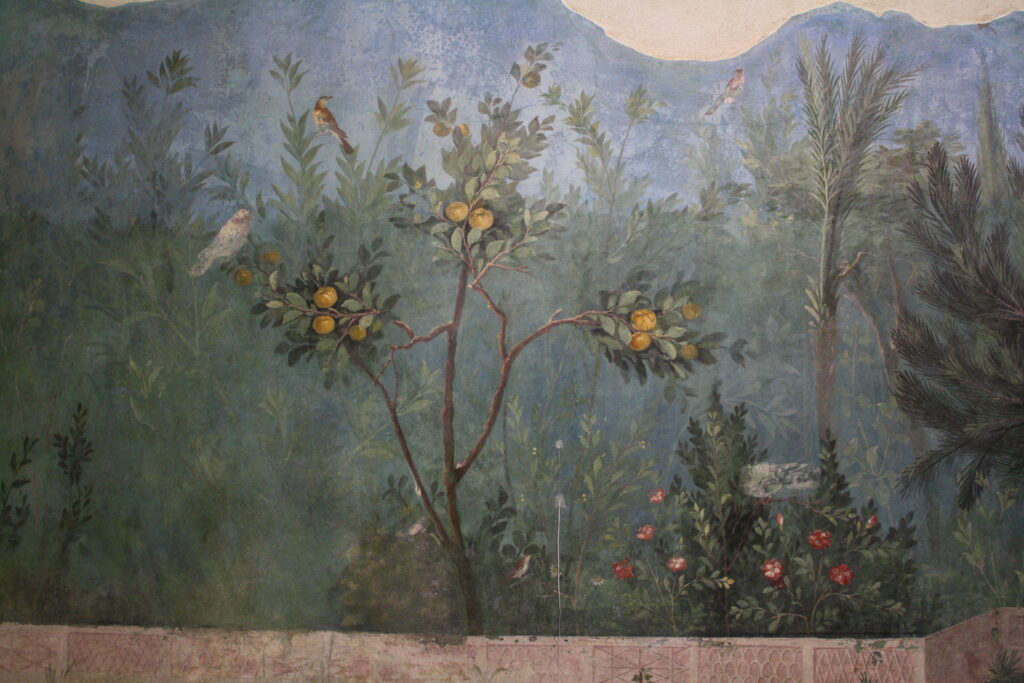
In the ancient world, earth pigments became integral to artistic systems across Egyptian, Mesopotamian, and Mediterranean civilizations. Egyptian wall paintings featured red and yellow ochres, as well as green earths, often combined with synthetic pigments like Egyptian Blue. In Greece and Rome, earth pigments were widely used in frescoes, sculpture polychromy, and architectural decoration. Etruscan tomb paintings relied heavily on earth-based reds and browns to depict human figures and interior scenes. These pigments also played roles beyond painting—used in cosmetics, religious rituals, and body adornment—across both the Mediterranean and regions of South America. While many pigments were locally sourced, trade in earth pigments, particularly high-quality ochres, has been documented throughout the ancient world.
During the Medieval and Renaissance periods, earth pigments formed the core of the artistic palette. Siennas, umbers and green earths were favored for rendering flesh tones, shadows, and underpaintings in panel and manuscript painting. Red ochres, provided a stable and affordable alternative to more expensive pigments such as vermilion or cinnabar. Their lightfastness, non-toxicity, and versatility made them indispensable in fresco, tempera, and early oil techniques.
In the Early Modern period and throughout the Industrial Age (17th–19th centuries), earth pigments remained widely used, though increasingly refined and commercialized. Companies such as Winsor & Newton and Kremer Pigmente began cataloging and distributing standardized earth pigments to professional artists. As academic painting flourished, earth pigments were commonly employed for imprimatura layers or tonal grounds. Even with the rise of synthetic pigments in the 19th century, natural earth pigments retained their appeal, thanks to their compatibility with traditional binders and enduring historical presence. Today, earth pigments continue to be valued in both contemporary art and heritage conservation. Artists seeking sustainable, non-toxic alternatives frequently incorporate them into natural palettes. In conservation, their mineral stability and availability make them ideal for retouching. Additionally, renewed interest in indigenous, vernacular, and community-based practices has brought further attention to the cultural relevance of naturally sourced earth pigments in both historical and living traditions.
Earth Pigments in the INFRA-ART Database
The INFRA-ART Spectral Library contains a curated collection of natural earth pigments that currently comprises around 100 samples. These earth pigments span a wide range of hues and geological origins—from iron-rich ochres of Andalusia, green earths from Cyprus, and umbers from Germany and Italy, to unique deposits from Morocco’s Midelt region and volcanic earths near Iceland’s Snæfellsjökull. Sourced from diverse geological settings, these pigments exhibit variations in origin, mineral composition, and preparation methods, including fired variants such as burnt sienna and burnt umber. Their complex chemistry often involves mixtures of chromophore minerals (iron and manganese oxides/hydroxides) with accessory phases. Such compositions, together with distinctive geochemical fingerprints, make them valuable for provenance studies. Most samples have been analyzed via ATR-FTIR and XRF, with Raman and SWIR reflectance datasets currently in preparation. The database is periodically updated, with new samples added to expand its pigment diversity and analytical coverage.
Earth pigment samples and available spectral data in the INFRA-ART Spectral Library
Red Ochres
| Sample name | Provenance | Sample ID | Pigment supplier | Spectral data |
| Red Ochre from Andalusia | Andalusia, Spain | PK11273 | Kremer | FTIR, XRF, Raman |
| Red Ochre from Burgundy | Burgundy, France | PK11575 | Kremer | FTIR, XRF, Raman |
| Red Ochre from Burgundy (dark) | Burgundy, France | PK11577 | Kremer | FTIR, XRF |
| Red Ochre from Castille | Castille, Spain | PK11584 | Kremer | FTIR, XRF, Raman |
| Red Ochre from Iceland | Snæfellsjökull, Iceland | PK11550 | Kremer | FTIR, XRF, Raman |
| Red Moroccan Ochre (dark) | Midelt, Morocco | PK116440 | Kremer | FTIR, XRF |
| Red Moroccan Ochre (fine) | Midelt, Morocco | PK116431 | Kremer | FTIR, XRF, Raman |
| French Ochre RTFLES (washed) | France | PK40020 | Kremer | FTIR, XRF |
| French Ochre SOFOROUGE | France | PK40090 | Kremer | FTIR, XRF |
| Persian Red | Hormuz, Iran | PK17280 | Kremer | FTIR, XRF |
| Red Bole | Germany | PK40503 | Kremer | FTIR, XRF |
| Bole (ruby) | n/s | PK58270 | Kremer | FTIR, XRF |
| Haematite (intense tinting) | n/s | PK48651 | Kremer | FTIR, XRF |
Yellow Ochres
| Sample name | Provenance | Sample ID | Pigment supplier | Spectral data |
| Yellow Ochre (deep) | n/s | PK40301 | Kremer | FTIR, XRF |
| Yellow Ochre from Andalusia | Andalusia, Spain | PK11272 | Kremer | FTIR, XRF, Raman |
| Yellow Ochre from Burgundy | Burgundy, France | PK11573 | Kremer | FTIR, XRF, Raman |
| Yellow Ochre from Iceland | Snæfellsjökull, Iceland | PK11551 | Kremer | FTIR, XRF, Raman |
| Yellow Ochre (light) | n/s | PM132 | Maimeri | FTIR, XRF |
| French Ochre (extra light) | France | PK40013 | Kremer | FTIR, XRF |
| French Ochre JCLES (washed) | France | PK40040 | Kremer | FTIR, XRF |
| French Ochre JFLES (washed) | France | PK40050 | Kremer | FTIR, XRF |
| French Ochre JOLES (washed) | France | PK40030 | Kremer | FTIR, XRF |
| French Ochre JTCLES (washed) | France | PK40010 | Kremer | FTIR, XRF |
| French Ochre SAHARA | France | PK40130 | Kremer | FTIR, XRF |
| French Ochre SOFODOR (golden) | France | PK40070 | Kremer | FTIR, XRF |
| Satin Ochre, Monte Amiata (gold-orange) | Tuscany, Italy | PK40260 | Kremer | FTIR, XRF, Raman |
| Taunus Ochre (light) | Hesse region, Germany | PK11540 | Kremer | FTIR, XRF, Raman |
| Gold Ochre from Poland | Carpathian Mountains, Poland | PK40195 | Kremer | FTIR, XRF, Raman |
| Gold Ochre from Germany | Saxony, Germany | PK11530 | Kremer | FTIR, XRF, Raman |
| Gold Ochre | n/s | PSC18621 | Schmincke | FTIR, XRF |
| Italian Gold Ochre (light) | Venice, Italy | PK40220 | Kremer | FTIR, XRF, Raman, SWIR |
| Ochre Avana (greenish-yellow) | Italy | PK40200 | Kremer | FTIR, XRF, Raman |
| Bole (yellow) | n/s | PK58275 | Kremer | FTIR, XRF |
Brown Ochres and Umbers
| Sample name | Provenance | Sample ID | Pigment supplier | Spectral data |
| Brown Earth from Otranto | Otranto, Italy | PK11620 | Kremer | FTIR, XRF, Raman |
| Brown Ochre from Andalusia | Andalusia, Spain | PK11276 | Kremer | FTIR, XRF, Raman |
| Caledonian Brown | Morocco | PK40623 | Kremer | FTIR, XRF, Raman |
| German Brown Ochre (light) | Germany | PK40231 | Kremer | FTIR, XRF, Raman |
| Raw Umber from Cyprus | Cyprus | PK40610 | Kremer | FTIR, XRF, Raman |
| Raw Umber from Cyprus (light) | Cyprus | PK40611 | Kremer | FTIR, XRF |
| Raw Umber from Cyprus (slightly greenish) | Cyprus | PK40660 | Kremer | FTIR, XRF |
| Raw Umber from Italy (greenish) | Italy | PK40612 | Kremer | FTIR, XRF, Raman, SWIR |
| Fawn Ochre (very light umber, greenish) | Germany | PK40241 | Kremer | FTIR, XRF, Raman |
Siennas
| Sample name | Provenance | Sample ID | Pigment supplier | Spectral data |
| Raw Sienna, French | France | PK40392 | Kremer | FTIR, XRF, Raman |
| Raw Sienna, Italian | Tuscany, Italy | PK40400 | Kremer | FTIR, XRF, Raman, SWIR |
| Raw Sienna, Italian (brownish) | Tuscany, Italy | PK40410 | Kremer | FTIR, XRF, Raman |
| Raw Sienna Badia, Italian | Badia, Italy | PK40404 | Kremer | FTIR, XRF, Raman |
| Natural Sienna | Grosseto, Italy | PK17050 | Kremer | FTIR, XRF |
| Raw Sienna Light | n/s | PM162 | Maimeri | FTIR, XRF |
Burnt Siennas and Burnt Umbers
| Sample name | Provenance | Sample ID | Pigment supplier | Spectral data |
| Italian Burnt Sienna | Italy | PK40430 | Kremer | FTIR, XRF, Raman, SWIR |
| Burnt Sienna | n/s | PSE211 | Sennelier | FTIR, XRF, Raman, SWIR |
| Burnt Umber | n/s | PM492 | Maimeri | FTIR, XRF |
| Burnt Umber | Cyprus | PK40723 | Kremer | FTIR, XRF |
| Burnt Umber (reddish-brown) | Cyprus | PK40730 | Kremer | FTIR, XRF |
| Burnt Umber from Cyprus (brownish) | Cyprus | PK40710 | Kremer | FTIR, XRF, Raman |
| Burnt Umber from Cyprus (dark brown) | Cyprus | PK40720 | Kremer | FTIR, XRF |
| Burnt Green Earth (reddish) | n/s | PK40850 | Kremer | FTIR, XRF |
| French Burnt Sienna | France | PK40470 | Kremer | FTIR, XRF |
Green Earths
| Sample name | Provenance | Sample ID | Pigment supplier | Spectral data |
| Green Earth (yellowish) | Germany | PK40800 | Kremer | FTIR, XRF |
| Green Earth from Cyprus | Cyprus | PK17400 | Kremer | FTIR, XRF, Raman |
| Green Earth from Cyprus (bluish) | Cyprus | PK17410 | Kremer | FTIR, XRF, Raman |
| Green Earth from Iceland | Snæfellsjökull, Iceland | PK11552 | Kremer | FTIR, XRF, Raman |
| Russian Green Earth | Russia | PK11110 | Kremer | FTIR, XRF, Raman |
| Russian Green Earth (extra fine) | Russia | PK11111 | Kremer | FTIR, XRF |
| Bavarian Green Earth | Bavaria, Germany | PK11100 | Kremer | FTIR, XRF, Raman |
| Verona Green Earth | Monte Baldo, Verona, Italy | PK11010 | Kremer | FTIR, XRF, Raman |
| Bole (green) | n/s | PK58273 | Kremer | FTIR, XRF |
Black and Violet Earths
| Sample name | Provenance | Sample ID | Pigment supplier | Spectral data |
| Black Earth from Andalusia | Andalusia, Spain | PK11280 | Kremer | FTIR, XRF, Raman |
| Bole (violet) | n/s | PK58272 | Kremer | FTIR, XRF |
| Iron Glimmer Violet | n/s | PK48930 | Kremer | FTIR, XRF |
| Iron Glimmer Violet (extra fine) | n/s | PK48933 | Kremer | FTIR, XRF |
Humic Earths
| Sample name | Provenance | Sample ID | Pigment supplier | Spectral data |
| Van Dyck Brown | Germany | PK41050 | Kremer | FTIR, XRF |
| Van Dyck Brown (dark) | Germany | PK41000 | Kremer | FTIR, XRF |
Further reading and resources
- Asscher, Y. et al. (2025). Implementation of Red Ochre in Sinopia: Non-invasive characterization of the invisible frescos beneath Roman and Byzantine mosaics in Judea. Journal of Archaeological Science 175, 106146. https://doi.org/10.1016/j.jas.2024.106146
- Becker, H. (2022). Pigment nomenclature in the ancient Near East, Greece, and Rome. Archaeological and Anthropological Sciences 14, 20. https://doi.org/10.1007/s12520-021-01394-1
- Cortea, I.M. et al (2022). Assessment of Easily Accessible Spectroscopic Techniques Coupled with Multivariate Analysis for the Qualitative Characterization and Differentiation of Earth Pigments of Various Provenance. Minerals 12(6), 755. https://doi.org/10.3390/min12060755
- Domingo, I. and Chieli, A. (2021). Characterizing the pigments and paints of prehistoric artists. Archaeological and Anthropological Sciences 13, 166. https://doi.org/10.1007/s12520-021-01397-y
- Eastaugh, N. et al. (2008). Pigment Compendium: A Dictionary and Optical Microscopy of Historical Pigments, 1st ed., Routledge.
- Feller, R.L., and Johnston-Feller, R.M. (1997) Vandyke Brown. In “Artists’ Pigments: A Handbook of Their History and Characteristics”, vol. 3, ed. Fitzhugh, E.W., Archetype Publications, pp. 157-190.
- Grifa, C. et al. (2025). Pompeian pigments. A glimpse into ancient Roman colouring materials. Journal of Archaeological Science, 106201. https://doi.org/10.1016/j.jas.2025.106201
- Grissom, C.A. (1986) Green Earth. In “Artists’ Pigments: A Handbook of Their History and Characteristics”, vol. 1, ed. Feller, R.L., Archetype Publications, pp. 141-167.
- Gustafson, H. (2019, Jun 5). Dust to Dust: A Geology of Color. The Side View 1(2). Available online: https://thesideview.co/journal/dust-to-dust/
- Gustafson, H. (2023). Book of Earth: A Guide to Ochre, Pigment and Raw Color. Abrams.
- Helwig, K. (2007). Iron Oxide Pigments: Natural and Synthetic. In “Artists’ Pigments: A Handbook of Their History and Characteristics”, vol. 4, ed. Berrie, B.H., Archetype Publications, pp. 39-109.
- Hirst, K.K. (2025, Apr 3). Ochre – The Oldest Known Natural Pigment in the World. ThoughtCo. Available online
- Knapp, C.W. et al. (2021). The ecology and bioactivity of some Greco-Roman medicinal minerals: the case of Melos earth pigments. Archaeological and Anthropological Sciences 13, 166. https://doi.org/10.1007/s12520-021-01396-z
- Marketou, A., and Rodler, A. (2025). Ochres as earth pigments in Hellenistic and Roman polychromy: State of the art and future directions on material origins and trade. Journal of Archaeological Science 180, 106276. https://doi.org/10.1016/j.jas.2025.106276
- Mastrotheodoros, G.P., and Beltsios, K.G. (2022). Pigments—Iron-based red, yellow, and brown ochres. Archaeological and Anthropological Sciences 14, 35. https://doi.org/10.1007/s12520-021-01482-2
- Montagner, C. at al. (2013). Ochres and earths: Matrix and chromophores characterization of 19th and 20th century artist materials. Spectrochimica Acta Part A: Molecular and Biomolecular Spectroscopy 103, 409-416. https://doi.org/10.1016/j.saa.2012.10.064
- O’Hanlon, G. (2023, Feb 19). Yellow Ochre: A Comprehensive Guide to Its History, Properties, and Uses. Natural Pigments. Available online
- Popelka-Filcoff, R.S., and Zipkin, A.M. (2022). The archaeometry of ochre sensu lato: A review. Journal of Archaeological Science 137, 105530. https://doi.org/10.1016/j.jas.2021.105530
- Rosso, D.E., Martí, A.P., d’Errico, F. (2016). Middle Stone Age Ochre Processing and Behavioural Complexity in the Horn of Africa: Evidence from Porc-Epic Cave, Dire Dawa, Ethiopia. PLoS ONE 11(11), e0164793. https://doi.org/10.1371/journal.pone.0164793
- Siddall, R. (2018). Mineral pigments in archaeology: Their analysis and the range of available materials. Minerals 8(5), 201. https://doi.org/10.3390/min8050201
- Velliky, E.C. et al. (2024). The Framework for Ochre Experiences (Foes): Towards a Transdisciplinary Perspective on the Earth Material Heritage of Ochre. In: Abadía, O.M., Conkey, M.W., McDonald, J. (eds) Deep-Time Images in the Age of Globalization. Interdisciplinary Contributions to Archaeology. Springer, Cham. https://doi.org/10.1007/978-3-031-54638-9_8
How to cite this resource
Cortea, I.M. (2025, Sep 2). INFRA-ART spectral data collections: earth pigments. INFRA-ART Blog.


